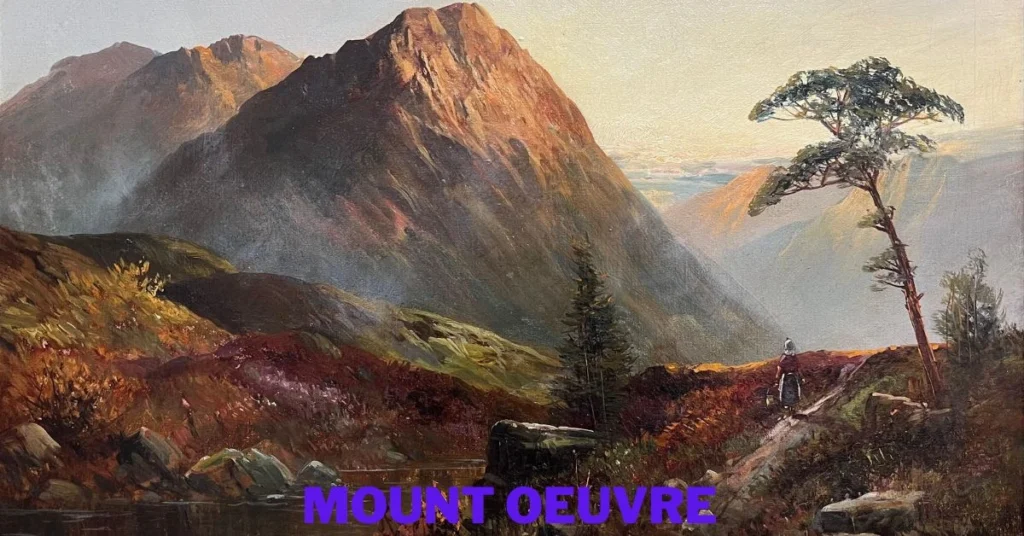Introduction
Art and culture have always been intertwined, reflecting the evolution of human thought and creativity. Among the many symbols of artistic and cultural achievement, “Mount Oeuvre” stands out as a metaphorical pinnacle. This term represents the ultimate summit in artistic expression and cultural significance. Throughout history, artists and creators have aspired to reach their own “Mount Oeuvre,” a place where their work achieves its highest potential. This essay explores the concept of Mount Oeuvre, examining its implications in various fields of art and culture, and the ways in which artists have strived to reach this symbolic peak.
The Concept of Mount Oeuvre
Mount Oeuvre symbolizes the zenith of artistic achievement. Just as a physical mountain represents the highest point of a mountain range, Mount Oeuvre denotes the ultimate goal in the realm of creativity and expression. This concept can be traced back to ancient civilizations where mountains were often seen as sacred places, embodying the divine or the sublime. In a similar way, reaching Mount Oeuvre signifies the attainment of a work that resonates deeply with its audience and stands the test of time.
In literature, reaching the Mount Oeuvre involves crafting works that not only reflect personal insights but also offer universal truths. For example, Shakespeare’s plays and novels are considered his Mount Oeuvre due to their profound impact on literature and culture. His works continue to be studied, performed, and admired for their exploration of human nature and societal issues.
Artistic Milestones and Mount Oeuvre
The pursuit of Mount Oeuvre in visual arts is often marked by milestones that push the boundaries of creativity and technique. Artists such as Leonardo da Vinci, Michelangelo, and Vincent van Gogh are renowned for their masterpieces that exemplify the concept of Mount Oeuvre. Da Vinci’s “Mona Lisa,” with its enigmatic smile and revolutionary use of perspective, represents the artist’s ultimate achievement. Similarly, Michelangelo’s “David” and “The Creation of Adam” are monumental works that capture the essence of Renaissance art and the artist’s quest for perfection.
For contemporary artists, reaching Mount Oeuvre might involve embracing new media and technologies. Digital art and installations push the traditional boundaries of artistic expression, offering innovative ways to engage with audiences. Artists like Banksy and Yayoi Kusama have made significant contributions to modern art, creating works that challenge conventions and resonate with contemporary audiences, thus reaching their own Mount Oeuvre.
Mount Oeuvre in Music
In music, Mount Oeuvre represents compositions or performances that achieve exceptional acclaim and influence. Classical composers such as Beethoven and Mozart have left legacies that exemplify their artistic peaks. Beethoven’s Ninth Symphony, with its profound choral finale, and Mozart’s operas, such as “The Magic Flute,” are considered masterpieces that define the Mount Oeuvre of classical music.
In the realm of popular music, achieving Mount Oeuvre might involve creating albums or performances that significantly impact the genre and culture. For instance, The Beatles’ “Sgt. Pepper’s Lonely Hearts Club Band” and Michael Jackson’s “Thriller” are iconic albums that represent the pinnacle of popular music and continue to influence artists and listeners worldwide.
The Role of Innovation in Reaching Mount Oeuvre
Innovation plays a crucial role in reaching Mount Oeuvre. Artists and creators who push the boundaries of their respective fields often achieve remarkable results. The pursuit of new techniques, styles, and ideas drives artistic evolution and leads to groundbreaking works. For example, the advent of Impressionism in painting, with artists like Claude Monet and Edgar Degas, marked a significant departure from traditional artistic methods, leading to a new way of perceiving and representing the world.
In literature, the stream-of-consciousness technique employed by writers such as James Joyce and Virginia Woolf represents a radical innovation that redefined narrative structure and character development. Their works, such as “Ulysses” and “Mrs. Dalloway,” reflect the artists’ quest for their Mount Oeuvre by exploring new ways of capturing human thought and experience.
The Influence of Cultural Context on Mount Oeuvre
Cultural context greatly influences the attainment of Mount Oeuvre. The significance of a particular work often depends on the cultural and historical moment in which it is created. For example, the art of the Renaissance reflects the cultural and intellectual revival of the time, while the Modernist movement in literature and art arose as a response to the rapid changes of the early 20th century.
In different cultures, the concept of Mount Oeuvre may manifest in various forms. For instance, traditional Japanese art forms like ukiyo-e and tea ceremonies have their own standards of artistic achievement that reflect the values and aesthetics of Japanese culture. Artists and creators within these traditions strive to reach their own Mount Oeuvre by adhering to established techniques and philosophies while also innovating within those frameworks.
Challenges and Triumphs on the Path to Mount Oeuvres
Reaching Mount Oeuvres is not without its challenges. Artists often face obstacles such as societal expectations, personal doubts, and the pressure of competition. The journey toward creating a masterpiece involves perseverance, resilience, and a willingness to overcome these hurdles.
Historical figures like Vincent van Gogh and Frida Kahlo exemplify the struggles and triumphs associated with reaching their artistic peaks. Van Gogh’s turbulent life and mental health issues did not deter him from creating iconic works that continue to captivate audiences. Similarly, Kahlo’s personal pain and cultural heritage deeply influenced her art, leading to a profound and enduring impact.
The Legacy of Mount Oeuvres
The legacy of Mount Oeuvres extends beyond the individual artist. Masterpieces that reach this symbolic peak become part of the collective cultural heritage, influencing future generations and shaping the course of artistic and cultural development. Institutions such as museums and libraries play a crucial role in preserving and showcasing works that have achieved Mount Oeuvres , ensuring that their significance endures.
For example, the Louvre Museum in Paris, housing da Vinci’s “Mona Lisa,” and the Metropolitan Museum of Art in New York, with its vast collection of masterpieces, contribute to the ongoing appreciation and study of these iconic works. The legacy of Mount Oeuvres is thus perpetuated through continued engagement with and interpretation of these remarkable creations.
Conclusion
Mount Oeuvres represents the highest achievement in art and culture, symbolizing the culmination of artistic vision and expression. Whether in visual arts, music, literature, or other creative fields, the pursuit of Mount Oeuvres drives artists to innovate, challenge conventions, and leave a lasting impact. The journey to reach this symbolic peak is marked by significant milestones, personal struggles, and cultural influences, reflecting the diverse ways in which artists strive for greatness.
By understanding the concept of Mount Oeuvres and its implications, we gain insight into the nature of artistic achievement and the enduring power of creativity. As we continue to explore and appreciate the masterpieces that have reached this summit, we honor the artists who have contributed to our cultural heritage and inspired future generations.
Read More: Play Heardle 60’s: Challenge Yourself with the Greatest Songs of the 1960s






